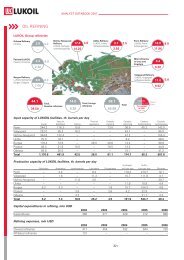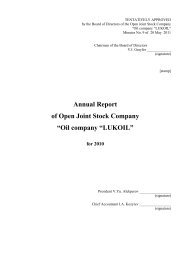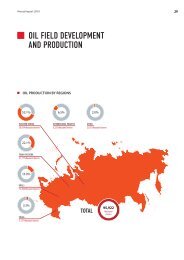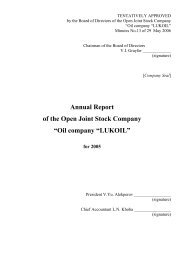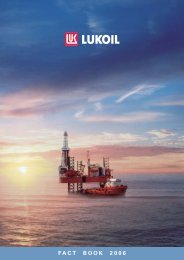ANNUAL REPORT 2005 - Lukoil
ANNUAL REPORT 2005 - Lukoil
ANNUAL REPORT 2005 - Lukoil
You also want an ePaper? Increase the reach of your titles
YUMPU automatically turns print PDFs into web optimized ePapers that Google loves.
generally determined as discounted future net cash flows. Assets to be disposed of are separately presented in the balance<br />
sheet and reported at the lower of the carrying amount or fair value less costs to sell, and are no longer depreciated.<br />
The assets and liabilities of a disposed group classified as held for sale are presented separately in the appropriate<br />
asset and liability sections of the balance sheet.<br />
Asset Retirement Obligations<br />
Under various laws, contracts, permits and regulations, the Company has legal obligations to remove tangible equipment<br />
and restore the land or seabed at the end of operations at production sites. The largest asset retirement obligations of<br />
the Company relate to wells and oil and gas production facilities and pipelines. In accordance with SFAS No. 143,<br />
"Accounting for Asset Retirement Obligations", the Company records the fair value of liabilities associated with such obligations<br />
when incurred. See Note 2 of the financial statements which describes the Company's adoption of SFAS No. 143<br />
effective January 1, 2003. Estimating the future asset retirement obligations costs necessary for this accounting calculation<br />
involves significant estimates and judgments by management. Most of these obligations are many years in the<br />
future and the contracts and regulations often have vague descriptions of what removal practices and criteria will have<br />
to be met when the removal event actually occurs. Asset removal technologies and costs are constantly changing, as<br />
well as political, environmental, safety and public relations considerations.<br />
ANALYSIS OF FINANCIAL CONDITION<br />
AND RESULTS OF OPERATIONS<br />
Contingencies<br />
The Company is required to both determine whether a loss is probable based on judgment and interpretation of laws and<br />
regulations and determine that the loss can be reasonably estimated. When the loss is determined it is charged to income<br />
statement. The Company's management must continually monitor known and potential contingent matters and make<br />
appropriate provisions by charges to income statement when warranted by circumstance.<br />
Pension Benefits<br />
Determination of the projected benefit obligations for the Company's defined benefit pension plan is important to the<br />
recorded amounts for such obligations on the balance sheet and to the amount of benefit expense in the income statement.<br />
This also impacts the required Company contributions into the plans. The actuarial determination of projected<br />
benefit obligations and Company contribution requirements involves judgment about uncertain future events, including<br />
estimated retirement dates, salary levels at retirement, mortality rates, lump-sum election rates and rates of return on<br />
plan assets. The judgmental assumptions used in the actuarial calculations significantly affect periodic financial statements<br />
and funding patterns over time. Benefit expense is particularly sensitive to the discount rate and return on plan<br />
assets assumptions. Due to the specialized nature of these calculations, the Company engages outside actuarial firms to<br />
assist in the determination of these projected benefit obligations.<br />
Recent Accounting Pronouncements<br />
In December 2004, the FASB issued SFAS No. 123(R) "Share-Based Payment", which revises SFAS No. 123 and supersedes<br />
Accounting Principles Board (APB) Opinion No. 25 regarding stock-based employee compensation plans. SFAS No.<br />
123(R) requires all share-based payments to employees, including grants of employee stock options, to be valued at fair<br />
value on the date of grant, and to be expensed over the applicable vesting period. The Group will adopt the provisions of<br />
SFAS No. 123(R) in the first quarter 2006 and is currently assessing the effect of adoption.<br />
In April <strong>2005</strong>, the FASB staff issued FASB Staff Position ("FSP") No. FAS 19-1 "Accounting for Suspended Well Costs".<br />
FSP No. 19-1 amends SFAS No. 19 "Financial Accounting and Reporting by Oil and Gas Producing Companies" to revise<br />
the criteria for continued capitalization of costs in relation to exploratory wells and exploratory-type stratigraphic wells.<br />
As amended, SFAS No. 19 allows continued capitalization of such costs for more than one year, provided (a) the well has<br />
found a sufficient quantity of reserves to justify its completion as a producing well and (b) the company is making sufficient<br />
progress assessing the reserves and the economic and operating viability of the project. If either condition is not<br />
met or if a company obtains information that raises substantial doubt about the economic or operational viability of the<br />
project, the exploratory well would be assumed impaired, and its costs, net of any salvage value, would be charged to<br />
expense. Following adoption of the changes, certain exploration costs which would have been charged to the income<br />
statement will remain capitalized and will instead be subject to depreciation, depletion and amortization in future periods.<br />
FSP No. 19-1 also requires certain additional disclosures in relation to suspended well costs. The adoption of the provisions<br />
of FSP No. 19-1 during <strong>2005</strong> did not have a material impact on the Group's results of operations, financial position<br />
or cash flows.<br />
133







